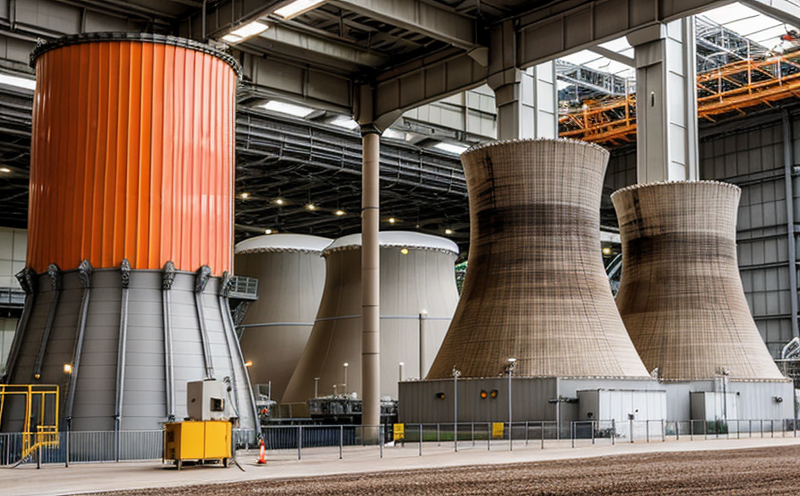ISO 204-3 Creep Testing at Elevated Temperatures for Nuclear Alloys
The ISO 204-3 standard is a critical component of quality assurance and compliance in the nuclear industry, particularly for materials used in nuclear power plants. This standard specifies procedures for determining the creep properties of metallic materials under stress at elevated temperatures over long periods. Creep testing is essential to ensure that reactor pressure vessels, piping systems, and other components do not fail due to gradual deformation under sustained high-stress conditions.
The creep behavior of materials in nuclear applications can be significantly influenced by factors such as heat exposure, irradiation, and service environment. The ISO 204-3 standard provides a standardized approach to evaluate the resistance of materials against this form of mechanical degradation, ensuring that they meet stringent safety requirements set forth by regulatory bodies.
Creep testing typically involves subjecting a specimen to a specific stress level at elevated temperatures for extended periods. During these tests, the deformation rate is monitored over time using precise measurement techniques. The results are then used to determine whether the material's creep properties comply with specified performance criteria outlined in ISO 204-3.
The testing process begins with careful selection and preparation of the test specimen. This may involve machining a sample from the actual component or fabricating a representative test part using the same materials as those found in the reactor vessel. Once prepared, the specimen is placed within an environmental chamber where controlled temperature and stress conditions are maintained throughout the duration of the test.
Accurate measurement of strain is crucial for interpreting creep behavior accurately. Modern testing systems employ sophisticated techniques such as laser interferometry or extensometers to record even minute changes in dimensions with high precision. These measurements provide valuable insights into how much a material will deform over time under given stress levels and temperatures, which is essential information when designing safe and reliable nuclear components.
After completing the creep test according to ISO 204-3 guidelines, detailed reports are generated summarizing all key parameters measured during the experiment. Compliance with relevant sections of this international standard ensures that manufacturers can demonstrate adherence to strict quality assurance protocols required by regulatory authorities like the International Atomic Energy Agency (IAEA).
Understanding creep behavior is paramount for ensuring long-term reliability and safety in nuclear installations. By conducting rigorous tests based on ISO 204-3 standards, laboratories like Eurolab contribute significantly towards maintaining public confidence in nuclear energy production processes.
Eurolab Advantages
- State-of-the-art equipment capable of simulating real-world operating conditions for accurate creep testing.
- Expertise and experience in performing ISO 204-3 tests with meticulous attention to detail.
- Absolutely secure handling of radioactive materials under strict safety protocols.
- Comprehensive support throughout the entire testing process, from specimen preparation to final report generation.
EuroLab boasts a team of highly qualified professionals dedicated to delivering reliable results. Our advanced facilities and rigorous adherence to international standards ensure that every test conducted meets the highest quality standards expected by our clients in the nuclear sector.
Customer Impact and Satisfaction
- Reassurance that compliance with ISO 204-3 standards enhances safety margins of nuclear facilities.
- Increased confidence among stakeholders regarding the integrity of materials used in critical components.
- Optimization of design parameters leading to longer service life and reduced maintenance costs.
Customer satisfaction is paramount at EuroLab. We strive to provide accurate, reliable results that contribute directly to enhancing safety protocols within nuclear plants while also optimizing operational efficiency through informed decisions based on our test findings.
Use Cases and Application Examples
| Case Study | Description |
|---|---|
| Reactor Pressure Vessels | Testing creep properties ensures structural integrity under prolonged exposure to high temperatures. |
| Nuclear Piping Systems | Evaluating materials for resistance against gradual deformation helps prevent potential leaks or failures during operation. |
| Turbine Blades | Determining the creep behavior of alloys used in turbine blades ensures optimal performance and longevity. |
| Case Study | Description |
|---|---|
| Irradiated Materials | Evaluating the effects of radiation exposure on creep properties helps assess long-term performance degradation. |
| Welded Joints | Determining the creep behavior in welded joints ensures that connections remain secure under sustained stress conditions. |
| Heat Exchangers | Evaluating materials used in heat exchangers provides insight into their ability to handle thermal cycling without compromising structural integrity. |
In each case, the results of creep testing according to ISO 204-3 are instrumental in validating the suitability of specific materials for use within nuclear power plants. This testing ensures that all components meet stringent performance requirements set by regulatory bodies and contribute to overall plant safety.





